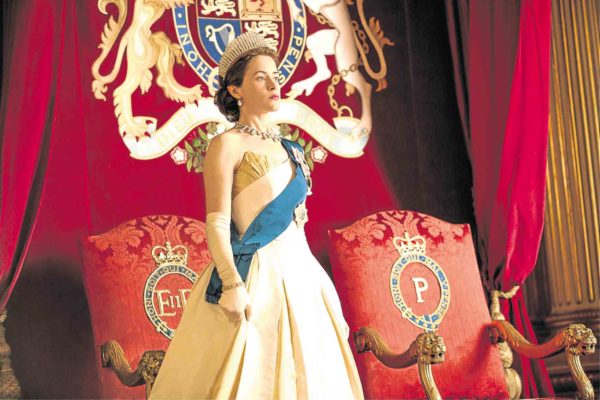The British monarchy is in the news again as it celebrates two momentous milestones that demonstrate a “changing of the guard” that vivifies how a modern royal family, now far removed from the constricting “Age of Deference,” moves in line with the times.
As 91-year-old Queen Elizabeth II and Prince Philip celebrate their 70th wedding anniversary, their grandson Prince Harry, who’s fifth in line to the throne, has announced his engagement to American actress Meghan Markle (“Suits”), a mixed-race Catholic divorcée. How’s that for color-blind inclusivity?
The warm welcome Meghan is getting from the royal family would have made King Edward VIII’s paramour, Wallis Simpson, green with envy. The former king chose to abdicate the throne in 1939 because of his love for the twice-divorced American socialite.
His abdication plays a significant role in the events depicted in the first season of Netflix’s “The Crown,” which chronicles the queen’s early reign. It starts with the fairy tale wedding of Queen Elizabeth II (the exceptional Claire Foy) and Prince Philip (Matt Smith) in 1947, and ends with the resignation of Prime Minister Winston Churchill (John Lithgow, a thespic force of nature), as well as Princess Margaret’s (Vanessa Kirby) heartbreaking decision not to marry her much-older fiancé, Peter Townsend (Ben Miles).
Series creator Peter Morgan has managed to take away the perception of dispassionate rigidity and self-entitled air often associated with stories about kings and queens. After Seasons 1 and 2, he has ingeniously mapped out four more seasons for the series, each covering roughly a decade of the queen’s reign.
From left: Michael C. Hall (as JFK), Jodi Balfour (Jackie Kennedy), Foy (Queen Elizabeth II) and Matt Smith (Prince Philip) —PHOTO COURTESY OF Netflix
If you enjoyed “The Crown’s” initial salvo last year, you’ll love Season 2 even more, because it further demystifies the lives of its protagonists.
The 10-episode second season, which begins streaming on Dec. 8, keeps the sophomore slump at bay by going for the emotional jugular, minus the vein-popping excesses of many screen dramas these days.
The show’s unprecedented scale and ambition are further amped up by the major political and global events that have helped shape the latter half of the 20th century.
If that sounds alienating, wait till you see how the series boldly stages some of its most intimate and “humanizing” moments—including Elizabeth’s tense “faceoff” with a fragile Jackie Kennedy (Jodi Balfour, who portrays John F. Kennedy’s lonely wife with crushing, soul-stirring vulnerability) in episode eight, after the queen gets wind of the former US First Lady’s less-than-spectacular first impression of her.
To allow you, dear readers, the opportunity to experience the show’s crucial plot points and side stories as they unfold, we will refrain from discussing them in detail.
Other notable scenes show Elizabeth and Philip at loggerheads over the widening chink in their marital armor (Episode 1) as Winston Churchill’s successor, Anthony Eden (Jeremy Northam), declares illegal war against Egypt over the Suez Canal—with tumultuous results!
Then, in a particularly poignant moment in Episode 2, the queen and her husband are shown exchanging thinly veiled romantic messages while the prince is on a five-month tour.
The next episode introduces a new lease on Princess Margaret’s (gloriously limned by the terrific Vanessa Kirby) romantic life when she meets society photographer Antony Armstrong-Jones (the dashing Matthew Goode), who isn’t intimidated by her social standing.
The show offers viewers a considerable chunk of thematic meat to chew on—like the queen’s intriguing friendship with Christian evangelist Billy Graham; the damning Marburg files in relation to Edward VIII’s alleged links with the Nazis; Elizabeth’s protocol-breaching decision to dance the foxtrot with the king of Ghana; and the scandalous Profumo affair in 1961.
“The Crown” consolidates its gains even further by showing how the monarchy has managed to stay relevant through the decades—by “grudgingly” adjusting to the perpetually evolving world around it.
Are the members of the royal family detached from the world outside Buckingham Palace? Far from it.
In fact, one of Season 2’s most compelling scenes shows Elizabeth secretly arranging a face-to-face meeting with her harshest critic, Lord Altrincham (John Hefferman), who, early on, described her as “priggish” and “tweedy,” after she delivered a shockingly insensitive speech in public.
Episode 5 beautifully “reimagines” this inspiring but chuckle-generating scene, which proves beyond any doubt that the world’s longest-reigning monarch isn’t as rigid as perceived. On Feb. 6 this year, Queen Elizabeth II became the first British monarch to celebrate a sapphire jubilee, commemorating her 65th year on the throne.
What’s the secret behind the queen’s mostly untarnished reign? Perhaps Episode 3 has the answer. In it, Elizabeth realizes that power doesn’t always go well with “royal” reticence.
She asserts, “To do nothing is often the best course of action. But, history isn’t made by people who do nothing.”
Love live the Queen!
